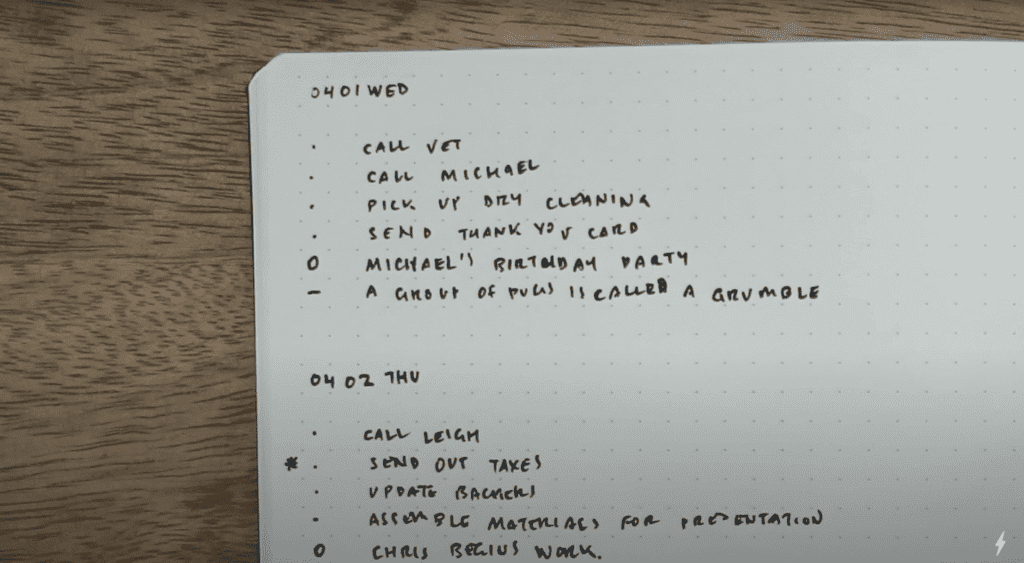Are you swamped by sticky notes and drowning in a deluge of to-do lists? Are you tired of flipping through endless agendas, drill-down spreadsheets, and groaning under disparate systems of productivity apps with cool names but non-cool results? Consider bullet journaling – the productivity game-changer you never knew you needed (until now, that is!).
What’s a bullet journal, you ask? Imagine a fun, creative space where your task lists, calendars, note-taking, and even inspirational quotes co-exist in harmony. Ah, the peace! A bullet journal is a way of documenting your professional life, allowing you to visualize, manage, and track your work life in an intuitive, accessible fashion. We’re talking about elevated productivity, limber organization, and overall efficiency galore.
“The goal of setting up a bullet journal for work is not only to keep you organized, but to make the process of organization enjoyable and creatively satisfying.”
Ryder Carroll, Inventor of the Bullet Journal Method
In this comprehensive guide, we’ll navigate the wonderful realm of the bullet journal method you can apply at work together and demonstrate how this deceptively simple system can reinvent your work life. Step by step, we’ll show you how to use your bullet journal to streamline tasks, plan and track projects, manage your time better, and yes, make meeting notes less of a chore. We’ll even explore personalizing your journal with motivational quotes, mindfulness practices, and a dash of decorative delight.
So let’s clear those sticky notes off the desk, shall we? Work life’s about to get a lot more organized… and more fun!
Table of Contents
Setting Up Your Work Bullet Journal: Key Supplies and Tools
First things first, before you can get all crafty and organized with the acclaimed bullet journal system, you need your tools. Let’s take a look at our essential toolkit.
- Notebook: You start with the core of it all, the humble notebook. You can go with a plain one, a dotted one, or if you’re feeling all fancy, a grid one. Size and thickness? Go with what tickles your fancy. Just remember, it should be decently sturdy to withstand a year’s worth of flipping, writing, and doodling.
- Pens: You need your weapons of choice, dear friends. Good-quality pens are a must. They are the extension of your thoughts. Consider a nice set of fine liners with varying thicknesses. Adding in various colors can be a boon but remember, simplicity is the charm of bullet journaling. Too many colors might just transform your field report into a rainbow explosion.
- Ruler: A portable ruler is good to have in your arsenal, just in case straight lines are your thing. Plus, it also gives you an undeniable feeling of power. A ruler by your side, and you’ll be slaying ‘chaos dragons’ left and right.
- Sticky Notes: Ever wanted to add a page but don’t fancy ripping everything apart? Enter, sticky notes! They’re perfect for those temporary notes, reminders, or heck, even to remind yourself of the coffee break after a daunting task.
- Markers: Page headers, key tasks, your boss’s surprise coffee preference? Markers can help you categorize, color-coordinate, or emphasize!
Nearly 80% of bullet journal users feel more in control of their work tasks
bulletjournal.com
Now, some of you might be thinking, “Alright, this is a lot to take in.” Do not panic! Enjoy the process and the journey as much as the destination. Invest in these tools (that probably you already have at home), and who knows? You just might morph into a bullet-journaling ninja. Productivity and organization, here we come!
Breaking It Down: How Does a Bullet Journal Work?
Now, let’s delve into how a bullet journal actually works. There are just a few simple, easy-to-implement steps. Promise!
At the core of the bullet journaling system lies three basic elements: bullets, collections, and indexing. Sounds a bit dry and somewhat complicated, doesn’t it? Let’s turn those confusing words into your ultimate productivity arsenal!
The bullet journal is an amazing tool that harnesses the power of bullets, collections, and indexing to craft your very own productivity powerhouse.
Decoding the Basics: Bullets, Collections, and Indexing
- Bullets: These aren’t the usual bullets you’re thinking of – our bullets are simple symbols that represent different types of entries.
- Collections: Collections are groups of related information that you can arrange according to the journal’s layout or your preference.
- Indexing: Indexing, a.k.a the tour guide of your bullet journal. Like a table of contents, it gives you a quick snapshot of where everything is located in your journal. Say goodbye to spending half an hour flipping through pages trying to find that one note!
The Magic Trio: Bullets, Collections, and Indexing as Table
| Elements | Details |
|---|---|
| Bullets | Simple symbols representing different types of tasks, events or notes. |
| Collections | Groups of related information that you can arrange as per your preferences. |
| Indexing | Helps you track the location of information in your journal, acting as a table of contents. |
And there you have it – the basic concepts of a bullet journal explained. Now, roll up your sleeves, grab that notebook and pen, and step into the enchanting world of bullet journaling.

Getting Started: Step-by-Step Guide to Creating Your Work Bullet Journal
First things first, you’re going to need a notebook. It could be any notebook; whatever suits your fancy, really. Checked, dotted, lined, or even blank pages, it’s up to you. I’m a sucker for the dotted ones though, real neat stuff. Oh, and a good pen. Do yourself a favor and invest in a nice, smooth writing pen. Your future self will thank you. Trust me on this.
Source: Reddit
Step 1: Create Your Index Page

Start by allocating the first couple of pages to your Index (yup, just like a book!). This is essentially your contents page, where you’ll write down all your collections and their respective page numbers. Handy, eh? It’ll be a lifesaver when you need to find something quickly.
The Magic of Numbering Your Pages
Let us begin by addressing the necessity of numbering pages in your bullet journal. In the often chaotic world of workplace bullet journaling, numbering your pages can be a significant lifesaver. Imagine not being able to locate vital information amidst growing pressure during a business meeting. Daunting, isn’t it? The simple yet effective practice of numbering your pages can help mitigate such situations.
Each page number serves as your very own GPS that directly leads you to your valuable work notes. This method of organization can dramatically reduce wasted time, helping to greatly enhance your productivity. Furthermore, coupling page numbers with your Index can hugely amplify the efficiency of your Bullet Journal system. Would you not appreciate such a superpower in your office toolkit?
Step 2: Set Up Your Future Log

The Future Log is for all those important upcoming dates and events that you don’t want to forget. Spread it across a couple of pages, chuck in the months, and note down any events or deadlines that you know about.
Step 3: Create a Monthly Log
Now, for my favorite bit. The Monthly Log! This is where you’ll jot down the tasks and events for the current month. It’s a simple two-page spread: on the left, you list the dates and days of the month, and on the right, the tasks or events corresponding to those dates.

Step 4: Dive Into the Daily Log

If the Monthly Log is the MVP, the Daily Log is the workhorse, the bread and butter of your Bullet Journal. This is where you’ll record all your daily tasks, notes, and events. Start this log on the page after your Monthly Log, adding dates as you go along.
Step 5: Collections and Custom Pages
Feeling creative? Good! ‘Cause this is where you can let your imagination run wild. Collections are entirely customizable pages that relate to your work. Say you need a page for meeting notes, a project tracker, or even a page to organize your Post-it notes collection. Go for it!
Don’t get too bogged down with making everything perfect. Remember, this Bullet Journal is your productivity tool. It’s supposed to help you, not stress you out! So go forth, start your journal, and let the fun begin!

Creating an Effective Task List: The Key to Organizing Your Workload
Ever get the feeling that your work to-do list is morphing into a never-ending marathon? Yes, me too. But don’t panic! There’s a way out of this quagmire: creating an effective task list using a bullet journal. Trust me, it’s the real deal when it comes to taming the wild beast that is your workload!
First things first: let’s get the basics right. We need to convert that jumbled mess of to-dos into a well-structured system governed by three bullet journal components: tasks, events, and notes.
- Tasks – This one is pretty straightforward (we’re not doing advanced physics here, people!). All your duties, responsibilities, and kick-butt-items-to-accomplish go under tasks, marked by simple dots or dashes.
- Events – Got a meeting with a client? A performance review? Mark these in small circles or squares.
- Notes – These are just information snippets you want to remember. Think of them as little nuggets of wisdom – like “don’t drink 5 coffees in a row if you value sleep”. Notes are often marked by dashes.
Now that we’ve got that set, let’s make that list more powerful. Here’s where the magic happens – with ‘signifiers’. These are special symbols that add extra context to your entries. Think of them as your very own secret code – how cool is that?!
- Asterisks can be used for important tasks. Because, let’s admit it, not all tasks are born equal.
- Exclamation points can be used for ‘Ah-ha’ moments or great ideas. “Invent caffeine tablets”, anyone?
- Eye symbols are perfect for things that require more research. Perhaps “find out if caffeine tablets exist”?
But listen up, the key to reigning in your workload is not just curating a killer list. You gotta review and update it regularly (yes, that means not conveniently forgetting about it after Tuesday!). Commit on a daily basis and see your productivity soar higher than your caffeine levels on a Monday morning.
With a clear and well-organized task list in your bullet journal, you’ll be the productivity hero!
Mastering Monthly and Weekly Spreads: Planning and Tracking Projects
Who’d have thought that tracking projects could be as satisfying as popping bubble wrap? Enter spreads. In a bullet journal, monthly and weekly spreads are exactly how they sound. They let you spread your tasks, goals, and milestones across the canvas of time, allowing for an eagle-eye view of your work very similar to a project roadmap. So, slather on that productivity—let’s get into it!
Let’s kick off with monthly spreads. These are your command centers for planning and tracking diverse projects in one place. Essentially, it’s a calendar and a snippet of everything you’re working on for the month.
- The Calendar: Start by creating a simple overview of the month. This can be a traditional grid calendar or just a numbered list of the days. There is no right or wrong way. Personally, I go with the original suggested list.
- Tasks: List your tasks for the month – everything that you gotta get done. You’re creating your very own cheat sheet here, plain and simple.
- Notes and Events: Include any important notes, events, or deadlines. Birthdays, Anniversaries? Heck no! We’re talking budgets due on the 15th and client proposals, pal!
Switching gears – your weekly spreads take a closer look at your tasks and time. Think of it like your microscope into your day-to-day tasks and short-term projects.
- The Weekly Overview: Usually, this is a two-page spread for the week ahead, with plenty of room for you to scribble, scribe, and track to your heart’s content!
- Project Breakdown: Break your projects down into actionable tasks and divvy ’em up throughout the week. It’s like managing your own little work army!
- Timelines or Time Blocks: If you’re feeling a bit time savvy, why not create timelines or time blocks to help manage your time and tasks better?
And voila, this is how you can’t not be on top of your stuff!
Remember, folks, this isn’t about creating a color-coded masterpiece each month (unless that’s your jam). At the end of the day, what matters is functionality. It’s about finding your groove that suits your style, makes you more productive, and helps you crush those work goals like the absolute legend you are. A word of wisdom from me though, practice makes it perfect. The more you use them, the better you’ll get. Now go ahead, seize your spreads!
Boosting Efficiency: How to Effectively Use Rapid Logging in Your Work Bullet Journal
What if I told you that you could significantly up your productivity game at work with just an itty-bitty change in how you jot info down? It’s time for me to unveil the humble little secret weapon we like to call Rapid Logging.
Rapid Logging is the beating heart of the Bullet Journal system. It’s a groovy method that goes against traditional long-winded note-taking. Instead of writing full sentences, what we’re bonkers about here are short and sweet phrases.
Rapid Logging is composed of four elements: topics, page numbers, short sentences, and bullets & signs.
- Topics – Identify your entry with a crispy short title.
- Page Numbers – Log this bad boy in your index to easily locate it later.
- Short Sentences – Just get to the point.
- Bullets & Signs – Bring your juiciest information to the forefront using these intuitive markers.
This system minimizes the fluff, optimizes information retention, and accelerates data entry. Woah, talk about multitasking!
How to Effectively Use Rapid Logging in Your Work Bullet Journal
Get started, my organizational warrior! Here’s how you can use Rapid Logging in your work bullet journal:
- Start with a topic: It’s like setting the stage. Your topic should be concise, giving you a quick snapshot of what’s contained.
- Use short sentences: Forget long, intricate sentences. Use brief phrases that get straight to the point without sacrificing comprehensibility.
- Implement bullet points: These are your lifelines. Each entry is represented by a bullet point that varies based on the content. It’s almost like creating your own secret shorthand language. Cool, right?
- Apply signifiers: Add extra context using symbols (or signifiers), making your entries scream “Look at me!”. Plot twist: your hieroglyphics actually make sense here! And yes, you can create the ones you like.
Rapid Logging is all about brevity and clarity. Are you ready to declutter your workload, one bullet at a time, like a true productivity ninja?
Meeting Madness: Streamlining Meeting Notes in Your Bullet Journal
Some days it feels like our work life is a never-ending cascade of scheduling conflicts, varied agendas, and flurries of hastily scribbled sticky notes. Certain meetings wrap up leaving you wondering what really transpired, while others are so dense with information you’ve been left feeling dazed and confused.
Reduce meeting chaos with a dedicated meeting notes section in your bullet journal. Stay informed and efficient in all meetings.
Deciphering the Doodles: Dividing Up Your Meeting Page
Before the meeting, start with a new dedicated page.
- Title and Date: The title of the meeting and the date go at the top. Seems obvious, right? But it’s surprising how many people skip this step.
- Attendees: Jot down who’s there. You know, for ‘historic reference’ and ‘covert office accountability’ and stuff.
- Agenda: Make frugal use of bullet points and list down the agenda of the meeting. This keeps the chit-chat on topic and redirects the discussion when Sid from the Marketing team starts digressing.
- Notes: This is where you let your pen fly. Record points discussed novel ideas, and “Ah-ha!” moments. Dash down those side—but crucial—commentaries. Your custom signifiers here can come in handy.
- Action Items: This is where the ‘real deal’ is. Who’s doing what? By when? Craft your to-do list straight away and save yourself the stress of remembering it later.
Remember, the main ingredient is ‘brevity’. You want the main ideas and relevant details – no need to transcribe Steve’s every metaphorical comment about ‘setting sail on the marketing sea’ (we get it, Steve).
Review, Reflect, React
After the meeting, take a gander over your notes. Are there tasks or ideas that intrigue you, rattle your brain, or demand your attention? Highlight them for easier navigation when you return to your notes for reference.
Revisiting the notes later, particularly before each new kindred meeting, also keeps projects moving and prevents tasks from slipping through the meeting cracks. Can you hear it? That’s the sound of your efficiency skyrocketing with just the flick of your pen!
Oh, and remember to find some joy in this process. This is your space, after all, might as well make it somewhat cheerier. Life’s too short for stark, sterile notes, right?
That’s it, folks. Feel free to customize any of these points to suit your needs and preferences.
Time Management Techniques: Using Time Logs and Timelines in Your Work Bullet Journal

Time logs and timelines can revolutionize how you manage your work hours, so buckle up and get ready to ride the wave of productivity!
Time Logs: Ever wished you could master time like a wizard controlling magic? Wish granted. A time log helps and guides you in tracking where your hours go during the day.
- Start by dividing a page into vertical sections or draw a grid. Each box then represents a unit of time, say an hour.
- Throughout the day, jot down what you did during each time slot. Whether it was attending a team meeting, responding to emails, or pulling silly faces at your colleague across the desk, write it all down.
- At the end of the day, look back to see how you spent your time. All those “quick” social media breaks might surprise you when added together.
Timelines: Have you ever felt like some days you’re whizzing through tasks at lightning speed, while others feel overwhelmingly sluggish? This common feeling can be effectively managed by utilizing timelines.
- Create a main timeline across the page for the day. Start at the left with your work start time and end at the right with your wrap-up time.
- Draw smaller, branch-like timelines for each task, extending from your main timeline. The longer the branch, the longer the task duration. Easy-peasy, right?
- Color code different tasks to distinguish between types of work. Who doesn’t love making their bullet journal as colorful as a unicorn’s sneeze?
Remember, you’re the boss of your day, not the other way around. It’s time for your bullet journal to help you take back control and show time who’s really running the show.
Tracking Progress: Utilizing Habit Trackers and Goal Pages for Work-Related Objectives
Our discourse shifts now towards a revolutionary dimension of the bullet journal landscape – the integral Habit Trackers and Goal Pages. Presented here is a tool capable of elevating your productivity. Picture if you will, the ability to seamlessly orchestrate your work-related ambitions from a state of disarray to one of immaculate organization. These are the powerful capabilities provided by these aforementioned components. Truly remarkable they are!
Habit Trackers: Your Personal Accountability Buddy
Habit trackers are like your personal accountability buddy on paper. They give you a visual of where you’re crushing it and where your game needs a little shaking up. A simple grid layout works wonders here. Name each column with a habit you want to track (‘Email responses’, ‘Client calls’, ‘Lunch breaks’, you get the drift), and each row represents a date. Every time you complete a habit, mark it down. Watching your progress (or lack of it) can be a huge, no, monumental motivator.
Goal Pages: Your Road Map to Success
Now, let’s move on to our next superhero, Goal Pages. This maverick has a single mission: to keep your eyes always on the prize. Setting up a Goal Page starts with defining your work-related goal and then breaking it down into digestible tasks. Think of it as embarking on a road trip; your goal is the destination, your tasks are the pit stops you need to make along the way, and your bullet journal is the trusty old map guiding you every step of the way. The satisfaction of checking off those tasks and tracking your headway is sweeter than your momma’s apple pie.
Pro tip: Try to keep your goals SMART – Specific, Measurable, Achievable, Relevant, and Time-bound. That way, you’re setting yourself up for success instead of chasing after dreams that are more elusive than Bigfoot himself!
There you have it! Habit trackers and goal pages in a nutshell. A game-changing duo that will revamp your work game and turn your bullet journal into a live, progress-tracking dashboard. And let’s face it, we all could use an extra shot of productivity in our work, right?
Taking Notes Like a Pro: Note-Taking Tips for Work in Your Bullet Journal
Alright, now let’s dive into the realm of note-taking. Scribbling down points during a meeting or brainstorming session can often feel like trying to capture a hurricane on a Post-it. BuJo is here to rescue you from the storm of disarray.
Remember, you’re a brave note-taking warrior, and your bullet journal is your fearless sidekick.
Listen, Don’t Just Hear
Step one in our note-taking adventure: Remember, listening is more than just hearing! It’s all about understanding the essence of the discussion. Instead of trying to jot down every single word, focus on the main ideas, strategies, and actionable points. Boom! Less clutter, more context.
Get Inventive with Symbols
Now, onto the fun bit. Use symbols to categorize your notes. For example, you might use an exclamation mark for important points or a question mark for queries to follow up on. (Did someone say they wanted an excuse to doodle? You got it!). This method not only saves you time but also allows you to easily scan your notes for specific information. Talk about being a smarty pants!
Create Visual Structures
Ever heard of concept mapping? It’s like taking your thoughts on a merry-go-round, but in a fun, organized way. You start with a central idea and then branch out into sub-points. It’s like creating a mini-map of your brain on paper. This method is ideal for visual learners who want an at-a-glance understanding of complex topics. Plus, it’s quite fun!
Review, Revise, Remember
Last but not least, reviewing your notes is as crucial as taking them. Set aside some time the same day or the next to revise your notes. Add additional points or clarifications if necessary. You retain information better when you review it soon after first learning it. Yes, your grade 6 science teacher was right…ugh!
In a nutshell, your bullet journal is more than just a notebook; it’s your professional wingman (or wingwoman!). It’s there to help you make sense of complex information and pull out the important bits.
Project Planning: Visualizing and Managing Work Projects in Your Bullet Journal
I’m about to demonstrate how a bullet journal can radically transform your approach to ‘Project Planning’ in your professional life. This technique could soon become synonymous with ‘Project Mastery’, as that’s precisely what you’ll be achieving in every instance. In no time at all, you’ll be managing multiple office projects with the expertise of a professional juggler, albeit without any of the accompanying circus hysteria.
First things first. Take a blank page, title it ‘Project X’ or whatever snazzy title your project has. This is the place where all your project-related stuff will hang out, much like that cozy corner coffee shop where everyone seems to know your name.
- Left-hand side: Establish a timeline for your project here. Key dates, milestones, and deadlines go into this space. Remember, folks, being specific is the name of the game here. ‘Complete the report’ is handy, but ‘Complete Draft 1 of the report by Wednesday’ is prizewinning.
- Right-hand side: This is where you break down the project into tasks. Feel free to get as anal-retentive as you wish. The more you can break it down, the less monumental and intimidating the project will look.
Alrighty, so where does the magic happen? You now have a map of your project. Congrats! But we ain’t done yet! Every day, when you create your daily log, check back with your project page. Any tasks that need to be accomplished that day get migrated to your daily log. And voila! From a massive intimidating project, you now only have to deal with bite-sized tasks.
But hey, what about those big meetings or brainstorming sessions that pop up in the middle of the project? Well, you simply dedicate the next new blank page for those, title it ‘Project X Meeting’, add it to your index, and jot down your notes there. Nifty, isn’t it?
I hear you asking, “What if my project spans across several months?” Have no fear, my friend. You can duplicate the structure of the project page in your monthly log and connect the collections with page numbering.
So there you have it! A bulletproof strategy to take control of your work projects. Take that, overwhelming project confusion! Hello, productivity and success!

Staying Motivated: Incorporating Inspirational Quotes and Mindfulness into Your Work Bullet Journal
Ever looked at your bulging work calendar and thought, “Heavens, how am I going to get through all this?” We’ve all had those moments – but that’s where the beauty of your bullet journal comes into play. Not only is it a mastermind at keeping you organized, but it’s an inspiration booster too! Let’s dive into it, shall we?
Source: Today.com
First, let’s talk about the power of uplifting quotes. You know, those snippets of wisdom that have you nodding your head and thinking, “Yes, I can take on the world! “ Incorporating these into your bullet journal can add a dash of motivation and positivity to your workday.
Here’s an idea – why not jot down a quote or two on your monthly spread? They’ll serve as gentle reminders to stay positive and focused. It’s like instant espresso for the soul – minus the caffeine jitters of course. Give it a try! It’ll keep those motivation levels topped up, promise.
Moving on to mindfulness – it’s not just a cool buzzword, folks! Mindfulness simply means staying present and aware, rather than zoning out into ‘robot mode’. Research suggests that just a pinch of mindfulness each day can work wonders for our stress levels and overall well-being. Now, who wouldn’t want that?
Here’s where your bullet journal can lend a big helping hand:
- Start with a reflection space in your daily log. Take a few moments at the end of each day to jot down what went well and what didn’t. Yeah, it’s a bit like a high five or a pep talk with yourself, but hey, we all could use one of those!
- Consider setting up a gratitude log. Sounds fancy schmancy, but it’s just listing a few things each day you’re grateful for. Doing this regularly can help you stay focused on the positive, boosting your happiness and motivation levels. Give it a whirl and watch the work blues fade!
So there you have it! Just a sprinkle of inspiration and mindfulness can make your bullet journal work even harder for you, keeping you motivated and in top form at work. Remember, your bullet journal is more than just a glorified to-do list – it’s a pocket-sized zen master, mind coach, and cheerleader all wrapped up in one. Use it well!
Troubleshooting: Common Challenges and Solutions When Using a Bullet Journal at Work
Up until now, we’ve been painting a pretty rosy picture, haven’t we? Good ol’ bullet journaling, the key to productivity, blah blah blah. But let’s cut to the chase. Despite all its glittering promises, this system can sometimes make you feel like you’re trying to ride a unicycle through a minefield. It can be tough! So, let’s dig into some common challenges you might face when applying the bullet journal method to your work life and, more importantly, let’s find some solutions! Shall we?
Challenge #1: Too Much Time Spent on Fancy Layouts
So you’ve found yourself spending more time decorating your journal than actually using it for getting things done? Has your bullet journal turned into an arts and crafts project? If every page of your journal resembles a Van Gogh painting, you might want to buckle down and get back to basics.
A solution? Simplicity is your new best friend. Remember, the purpose of a bullet journal is to save time. So chuck the fancy doodles and stickers and adopt a minimalist layout that gets the job done. And hey, if you need that creativity fix, just try and dedicate a separate ‘fun’ journal for your artistic impulses. You’re welcome!
Challenge #2: Losing Track of Tasks and Entries
Ever find yourself flipping manically through your bullet journal trying to find that one task you wrote down… somewhere? Nothing quite gets the heart pumping like losing track of tasks, does it?
Here’s how to solve this little headache: indexing, my friend. Invest some time in creating a detailed index page and update it regularly. Trust us; it’s worth it when you can find that all-important note from last Tuesday within seconds.
Challenge #3: Overwhelm with Complexity
Feeling a tad overwhelmed? Like you’ve created a labyrinth of logs, tasks, and collections? We can totally relate. It can feel like you’ve created Frankenstein’s monster, and now it’s slowly morphing into something unmanageable. But fear not!
The way out of this quagmire is to stick with essential collections that provide value. A monthly log, a daily log, a future log – keep the core intact. And don’t be afraid to ditch the rest if it’s not working. Remember, you’re the boss of your bullet journal, not the other way around!
In the end, folks, the bullet journal is a customizable tool. There might be some hiccups on the way as you find what works for you, but hey, that’s part of the journey!
Conclusion: Transform Your Work Life with the Power of a Bullet Journal
Well, folks, there you have it! Your very own guide to taking your work life by the horns and guiding it into a path of productivity using a work bullet journal. You’ve got your tools, your techniques, and a comprehensive guide to get you started. Now it’s all on you. Are you ready to make that leap?
Just imagine it—no more forgotten tasks, overlooked meeting notes, or chaotic project plans. Gone are the days of drowning in an ocean of Post-its and digital to-do lists.
Instead, imagine yourself with a bullet journal in hand, feeling in control and ready to seize the day, every day! You’re sailing on the smooth seas of organization, navigating the winds of productivity with your bullet journal as the captain of your ship.
Using a bullet journal for work is so much more than just staying organized. It’s about achieving peace of mind. It’s about keeping everything in one, accessible place where you can easily find what you need, prioritize your tasks, and keep track of your progress.
Did someone say increased productivity? You betcha! You’ll find that with the effective use of rapid logging, time logs, habit trackers, and visual project plans, your bullet journal becomes your personal productivity booster, helping you accomplish more than you ever thought possible.
Don’t worry about getting everything perfect or straight out of an Instagram feed. This isn’t about perfection; it’s about finding a system that works for you.
Embrace the power of the bullet journal and dare to transform your work life. The world of productivity awaits. So, go ahead, grab that pen, open your notebook, and let’s get bullet journaling!
Who knows, you might just wonder how you ever managed your work-life without it. Happy journaling!

Leave a Reply